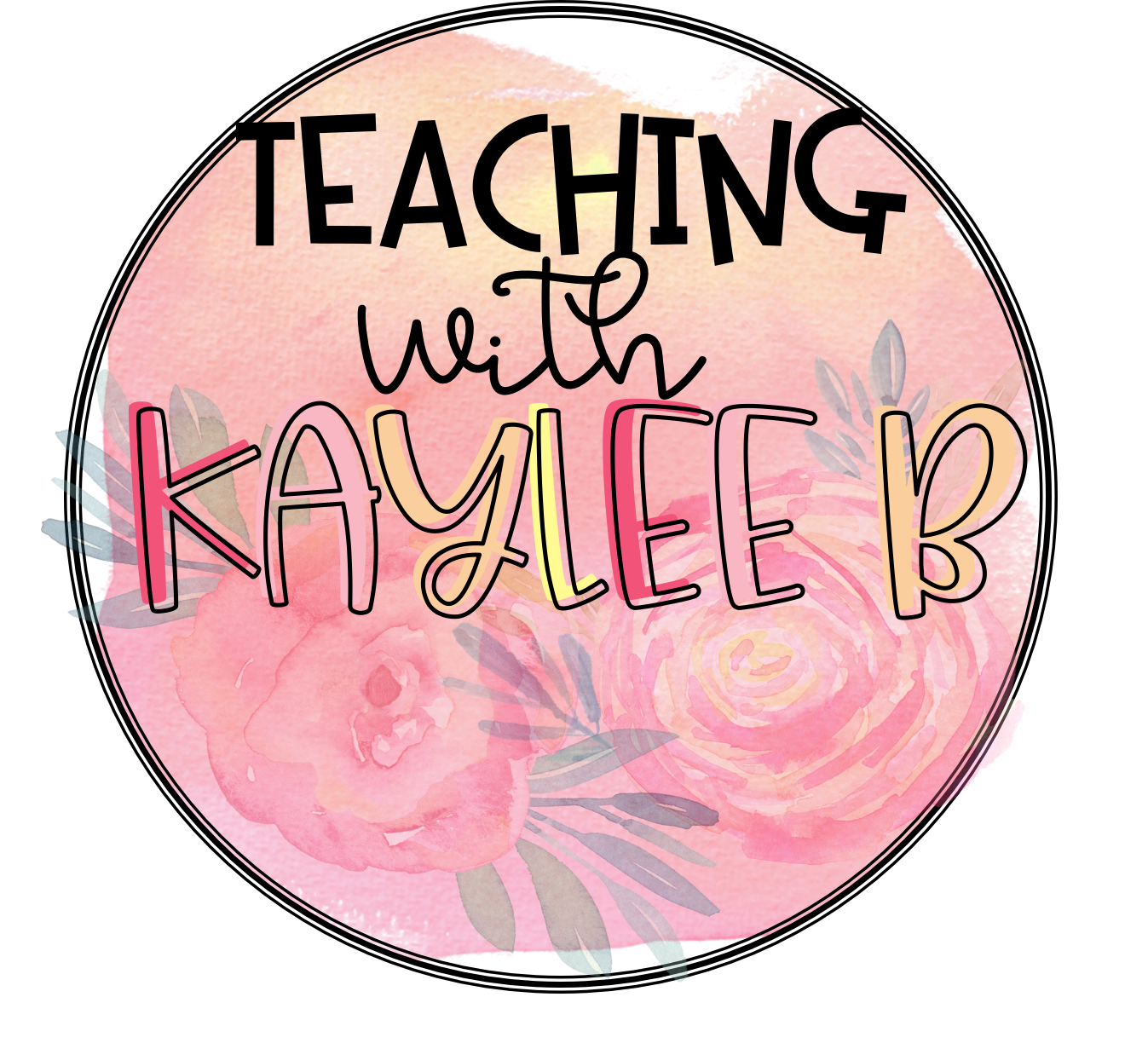When someone says “easy multiplication facts” I automatically think of facts where we multiply by 0 or 1. These have easy multiplication tricks to follow. When we times by 0, the answer is always 0. And when we multiply a number by 1, the number stays the same.
We could teach these as rote rules for our students to follow. But the reality is, they will find more understanding and will remember them better when we teach them with meaning.
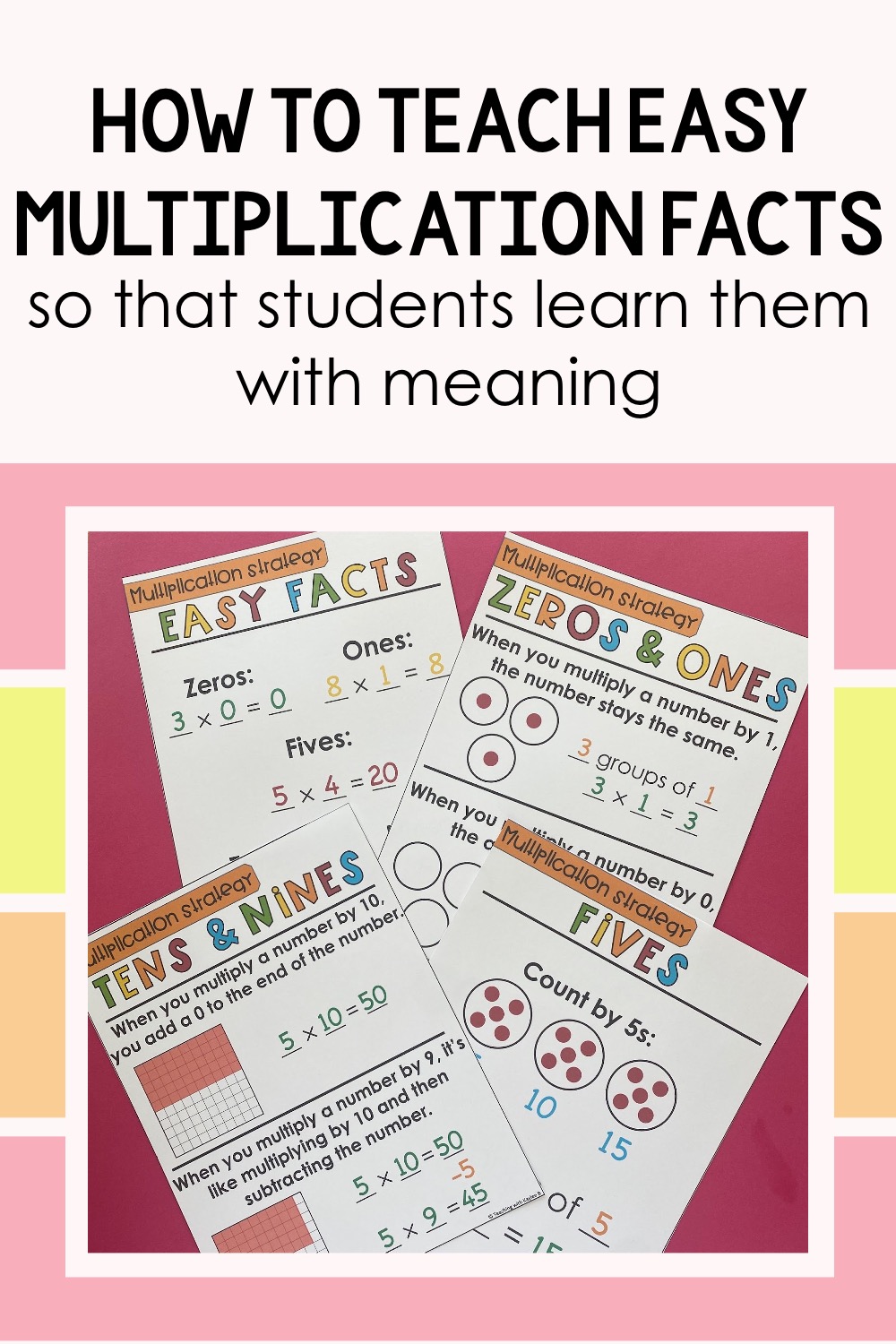
These are easy multiplication facts because students can use patterns and rules to quickly find the answer.
How do we teach easy multiplication facts with meaning?
We help students discover these rules for themselves through word problems and models. And that’s what I’m going to share in this blog post, how to teach facts of 0, 1, 5, 9, and 10 in a meaningful way.
Before I teach these facts, I like to help students really understand what multiplication means. Read all about how I do that in this blog post here: 4 Essential Multiplication Models That Set the Foundation to Fluency
Easy Multiplication Facts
Why do I also consider multiplication facts of 5, 9, and 10 easy multiplication facts? It’s because students can easily use patterns or simple reasoning to find the answers. With enough practice, these patterns become second nature to students. They commit the facts to memory quickly or can just use the reasoning quickly.
I teach these facts in 4 different lessons: zeros & ones, fives, tens & nines, and then a review lesson on all these facts.
For these lessons I provide direct instruction, guided practice, independent practice, extra practice, and assessment. Find all of my materials to do that in this Easy Multiplication Facts Bundle here.
Now let’s get into how I teach these facts by helping students discover the rules or “tricks” for themselves.
Easy Multiplication Tricks
Zeros & Ones
I introduce facts of ones with a word problem. “A grapefruit weighs about 1 pound. If you buy 4 grape fruits, how much do they weigh in total?”
I show how to represent this easy multiplication question with a set model. How many groups are there? 4. How many in each group? 1. Then we write a repeated addition equation and then the related multiplication equation.
We practice another word problem by drawing the set model and then writing the repeated addition question and the matching multiplication equation.
After that I show my student a bunch of area models that show these kinds of multiplication equations. Then I ask my students what patterns they see.
They can easily see that when you multiply a number by 1, the number stays the same.
I reinforce this easy multiplication trick by then posting up a ton of multiplication equations where you multiply by 1. We solve those together and use the pattern that students just discovered.
Then we move onto facts of zero.
I follow a similar format where I start by sharing a word problem. “A box of colored pencils contains 0 erasers. If you buy 3 boxes, how many erasers are in the boxes?”
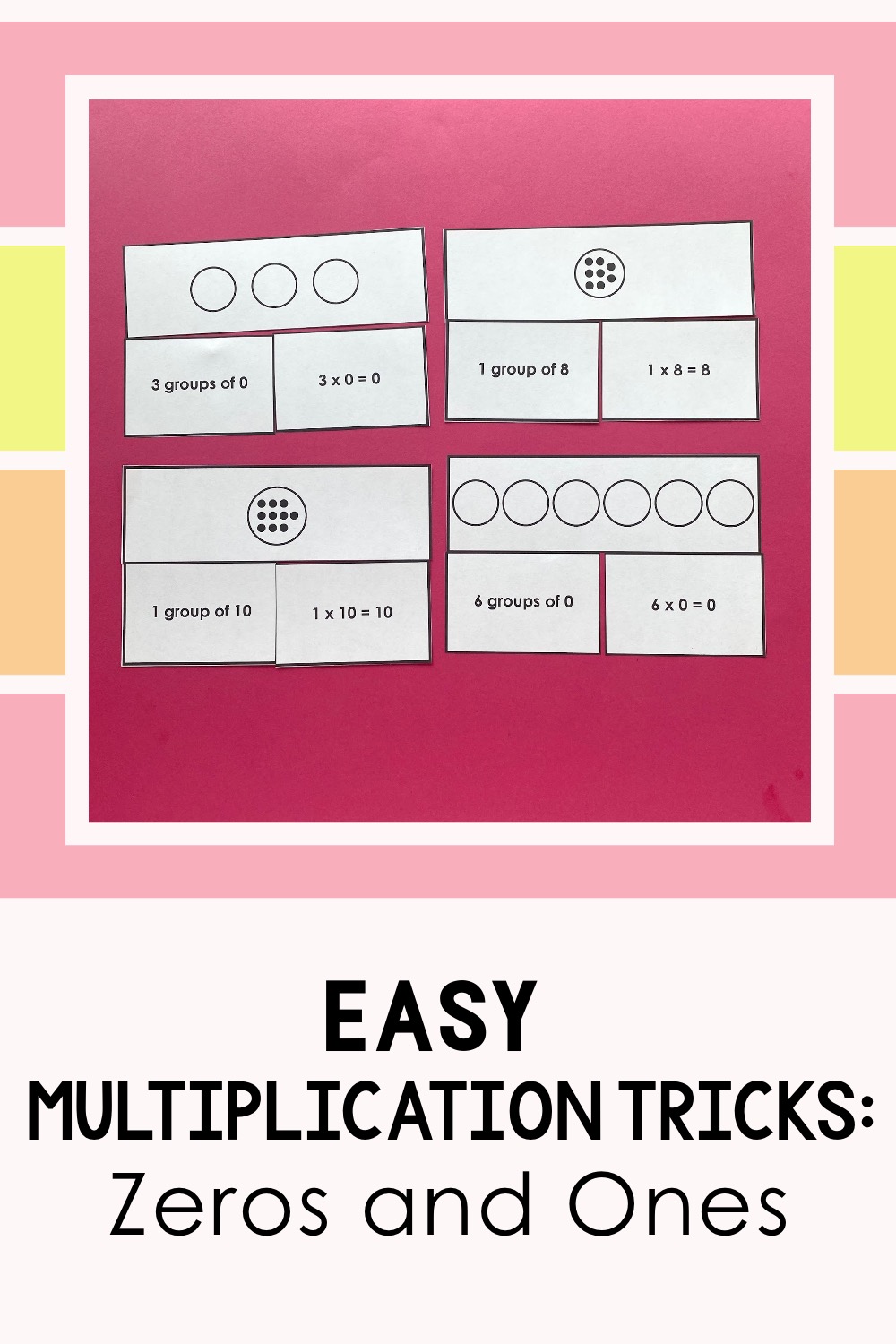
Help students visually see the easy multiplication tricks that come with multiplying by 0 and 1.
We draw a set model where we draw 3 circles to represent the boxes. How many erasers are in each box? 0. So we don’t draw anything in the circles. What’s our repeated addition equation: 0+0+0=0. And what’s the multiplication equation to represent it? 3×0=0
I show students another word problem to really solidify the meaning behind these facts.
Then I show different area models for multiplication facts of zero. I ask students what patterns they see. They can see that when you multiply a number by 0, the answer is always 0.
Then we solve a bunch of problems together using that rule.
Now it’s time for students to get their own practice. I have them do a worksheet with different word problems where they multiply by 1 or 0. Just like in our direct instruction, students draw the set models and write the repeated addition equation and matching multiplication equation.
They do a worksheet where they draw the area models for these easy multiplication facts and then worksheets where they just write the answer.
But I want students to get even more practice. So I have them do a scoot activity with a partner. For this activity, I tape task cards up around the classroom. These task cards have facts of 0 and 1 on them. Students go around the room with their partner solving the facts and writing their answer down on a recording sheet.
With that same partner I have them complete a facts of 0 and 1 math puzzle. Students line up the set models with the equations they represent. I love to have students work with a partner on this activity because it gets them talking about the math. They are naturally sharing the multiplication patterns, rules, and tricks they learned from the lesson.
Then I give students a quick exit ticket to check their understanding. I may pull students during centers to help them work on these facts if needed.
Find all the resources I use to teach multiplication facts of zero & ones here.
After that, students are ready for our next easy multiplication fact lesson: fives.
Quick Multiplication Facts
I consider multiplication facts of 5 quick multiplication facts because students can quickly count by 5s to find the answer.
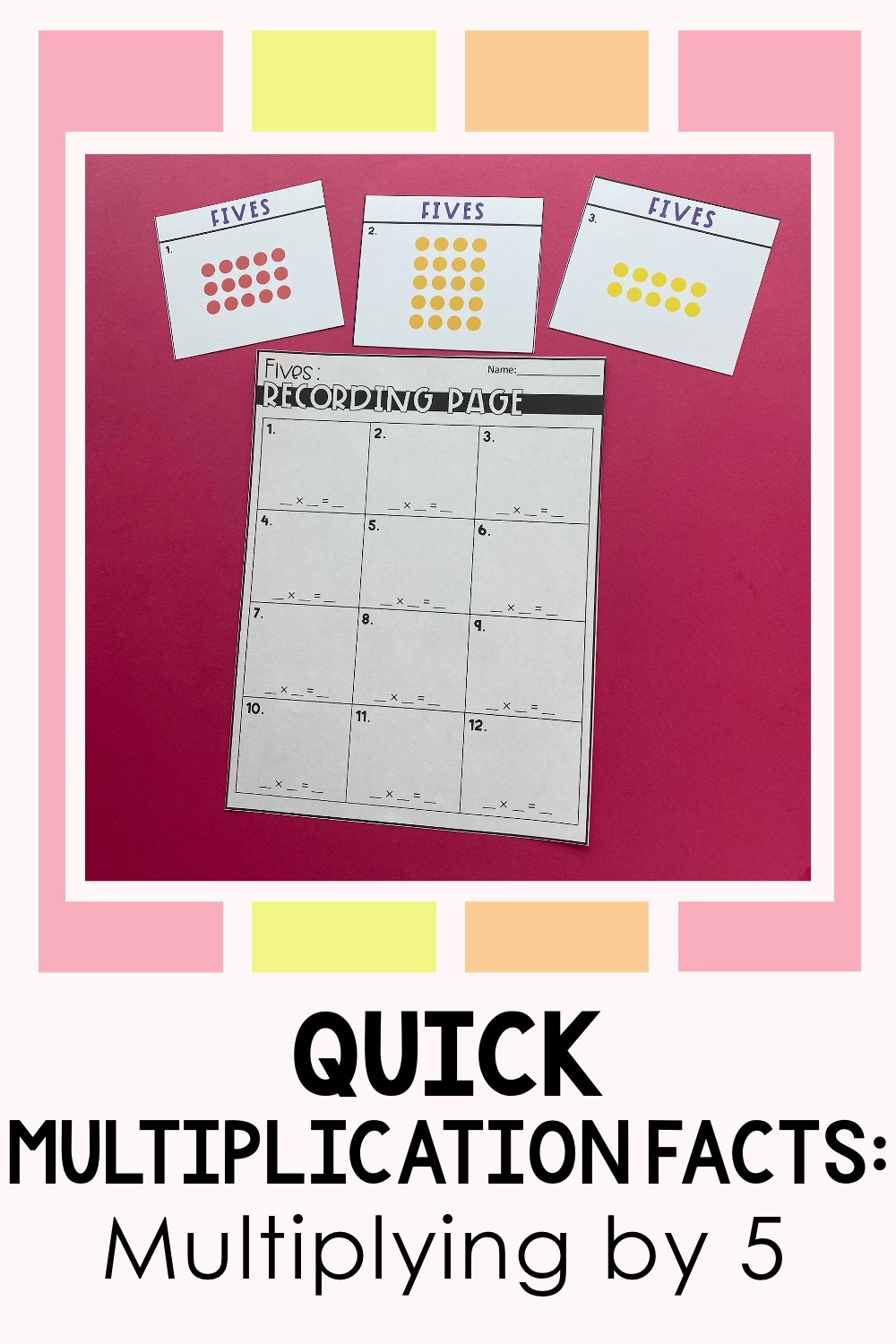
Facts of 5 are quick multiplication facts because students can quickly count by 5 to find the answers.
To help students see this, I show a set model that has 6 groups of 5. We count by 5s, write a repeated addition equation, and the related multiplication equation.
Then we practice with another problem like this and then I show different area models and arrays of 5s. We also count by 5s to find those equations.
After that, students are ready for their own problems. They do worksheets that mirror the problems we did together as a class. Students count by 5s with set models and area models. Then we do worksheets where they just write the answer to different multiplication facts of 5.
After that, it is time to get students more engaging practice. I have students do a scoot activity with a partner. They go around to the different task cards I have posted up around the classroom. The task cards show different arrays of multiples of 5s. Students write the equation that matches the array.
Then students do a puzzle activity with that same partner. They line up the puzzle piece that counts by 5 with its matching equation and the answer. This helps reinforce the concept that students can count by 5s to quickly find the answer to these kinds of facts.
Finally, students do a quick exit ticket for me to check their understanding. I’ll take a quick look at these after school to determine who could use a little more practice.
Then students are ready to learn facts of 10 and 9.
Multiplication Facts Made Easy
When students see how they can use simple reasoning to quickly find the answer to multiplication facts, that’s how we make these facts easy.
Students quickly discover the trick to find facts multiplying by 10. Then they can take that trick and use some simple reasoning to quickly find the answer to facts multiplying by 9.

Multiplication facts of 10 and 9 are multiplication facts made easy because students can use the rule of multiplying by 10 to quickly find the facts of 9.
First, I help students discover the rule of multiplying a number by 10.
I use display pages that I use as slides. The first page shows different area models for equations multiplying by 10. We solve those together and I ask students what patterns they see. They see that when you multiply by 10, you add a zero to the end of the number. Then we solve a bunch of equations together to really solidify this pattern.
After that, I want to show students how they can easily find the answers to numbers multiplied by 9 by using the 10 pattern and some simple reasoning.
I show the area model for 4 times 10 and 4 times 9. For the 4 times 10 model, students can see that there are 10 groups of 4. For the 4 times 9 model, they can see there are 9 groups of 4. So to easily find 4 times 9, we can think of it as 4 less than 4 times 10. 40-4=36, so 4 times 9 is 36.
I show students an example of this with set models. There are 10 sets of 3. Students can see there are 30 dots altogether. To get 3 times 9, we just cross off one of those sets. 30-3=27, so 3 times 9 is 27.
Find the display pages I use to teach these patterns and reasonings here.
Then it’s time to get students their own practice. For guided practice and independent practice, I give them worksheets where they get more practice with area models, set models, and just fooling the reasoning to get the facts of 9.
But I want to make sure students have mastered these facts, so I also get them extra practice with a scoot activity and a puzzle activity.
For the scoot activity, I tape task cards up around the room. These have students solve the 10 fact first, then gives them a reminder to subtract the number to get the 9s fact. Like the previous scoot activities I’ve explained, students go around to the different cards and record their answers on a recording sheet.
These are great task cards to laminate and have your students use dry-erase markers on as a center activity. You can pull out this activity throughout the school year to get students the review and practice they need.
For the puzzle activity, students work together with a partner to line up the area model, to the equation, to the answer. There are both facts of 10 and facts of 9 so students can make connections between them and practice using the reasoning they learned to solve.
Then I’ll have students do a quick exit ticket so that I can see how they have mastered these facts. This helps me know what to review and if certain students could use more practice in centers.
Then I like to have one more lesson on these easy multiplication facts by doing a review day where I mix all these facts together.
Easy Multiplication Review
For my display pages, I show a multiplication wheel with 0 in the middle. I call on a student to share the rule we discovered for multiplying by 0. Then we work together to fill in all the facts of the wheel. We continue the same way with facts of 1, 5, 10, and 9.
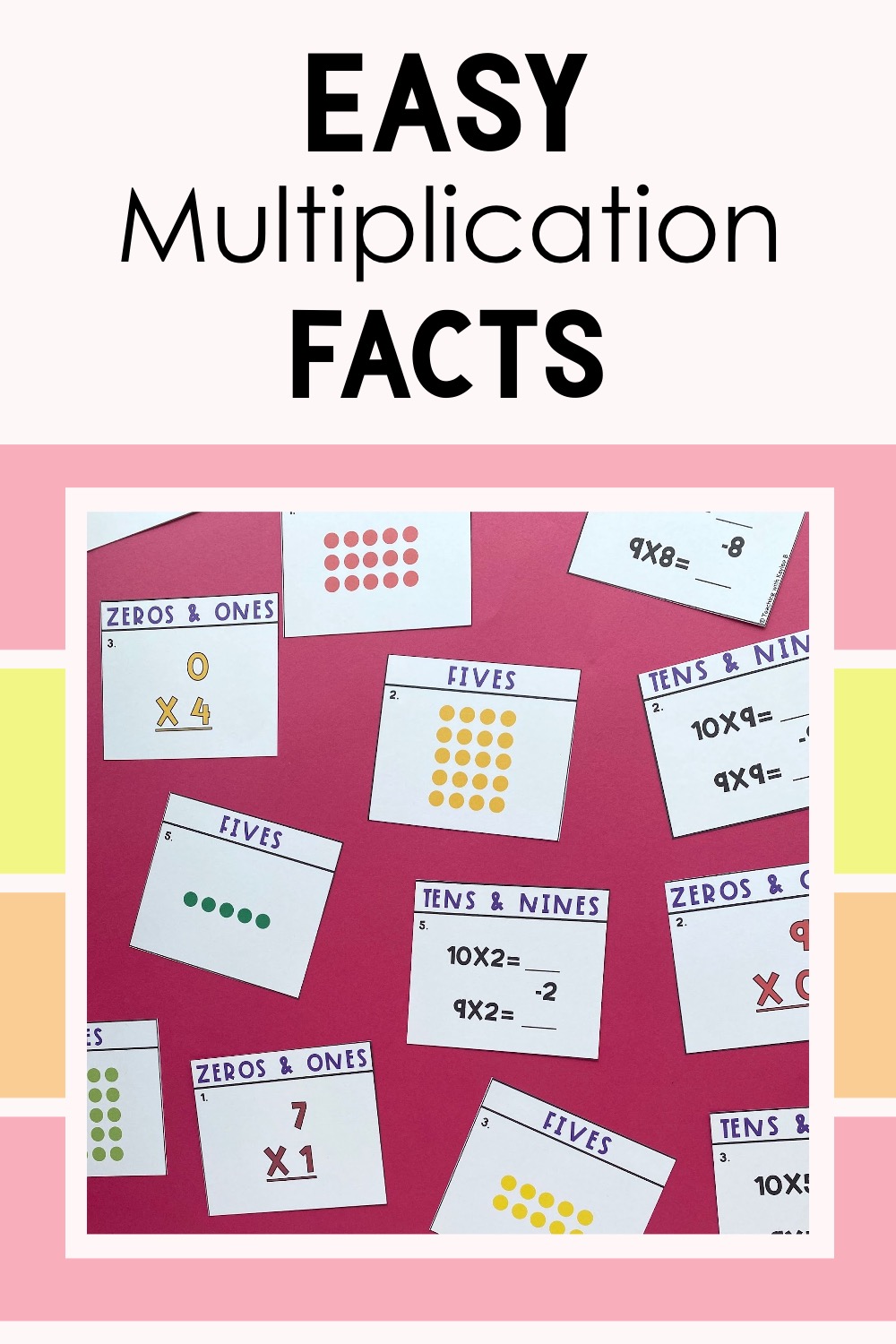
When teaching easy multiplication facts, have a review lesson to keep all of the easy multiplication tricks fresh in students’ minds.
Just like our earlier lessons, students get hands-on practice with worksheets, a scoot activity, and a puzzle activity.
Easy Multiplication Facts Covered in This Post:
- Facts of 0 & 1: Discover the rules through set and area models
- Facts of 5: Use repeated addition and counting by 5s
- Facts of 10 & 9: Build reasoning skills with 10s patterns
- Review Lesson: Reinforce all facts through practice and connection
Teaching easy multiplication facts doesn’t have to be boring or confusing. When students discover patterns and apply them through hands-on practice, these facts stick!
Grab my ready-to-use materials and start teaching multiplication facts with meaning today. I’ve bundled them so you can save time, save money, and feel confident knowing you have everything you need—all in one place. Find them here.
